Separation of Toluene
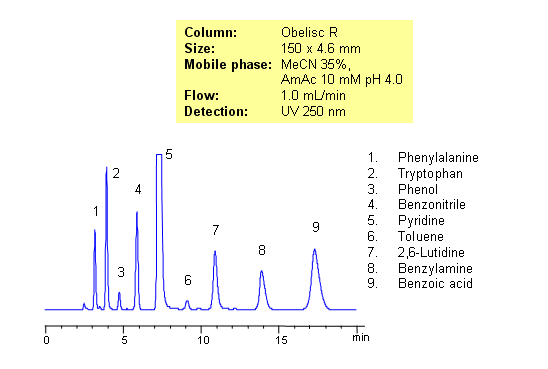
Get In Touch
Application Name : HPLC Separation of Amino Acids, Bases, Acids, and Neutrals on Obelisc R
Column Name : Obelisc R Columns
Analytes : Phenylalanine, Toluene, Benzoic acid, Benzonitrile, Benzylamine, Trypthophan, Phenol, Pyridine, 2,6-Lutidine
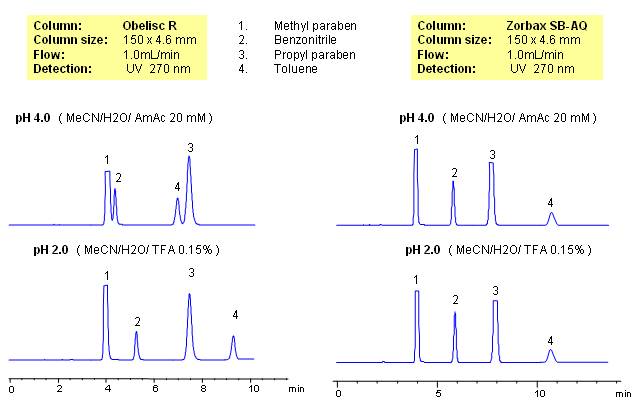
Parabens are common preservatives in pharmaceutical and cosmetic industries. They are esters of p-hydroxybenzoic acid. Method for separation of methyl paraben, propyl paraben, benzonitrile and toluene was developed on a Obelisc R column. All four compounds are neutral and are retained by reverse-phase mechanism. In case of reversed-phase stationary phase, no effect of pH is observed. Retention time for all four compounds changes on an Obelisc R column when pH is changed. pH of the mobile phase affects ionization state of stationary phase. Obelisc R column has C12 carbon chain and carboxylic acid with pKa of 4. At lower pH (pH 2, TFA), carboxylic acid of stationary phase is not ionized and thus adds hydrophobicity to stationary phase. Obelisc R column can be used for analysis of basic, acidic and neutral compounds with suitable detection techniques – UV, ELSD, CAD, LC/MS.
Application Name : HPLC Separation of Methyl Paraben, Benzonitrile, Propyl Paraben, and Toluene on Mixed-Mode and Reverse Phase Columns
Column Name : Obelisc R Columns
Analytes : Propyl paraben, Toluene, Methyl Paraben, Benzonitrile
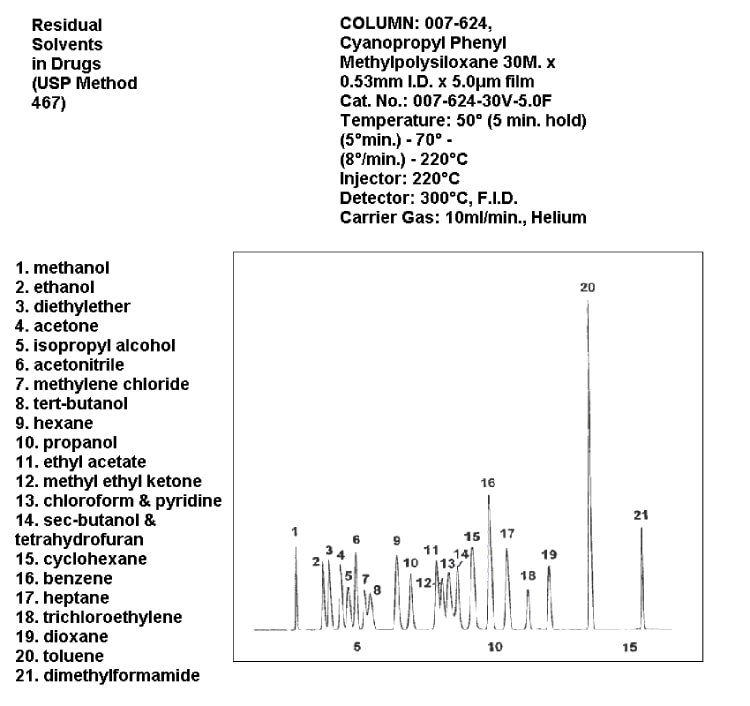
Application Name : Residual Solvents in Drugs (USP Method 467)
Column Name : GRS-624 GC Capillary Column
Analytes : Benzene, Toluene, Ethanol, Methanol, acetone, Hexane, Heptane, Trichloroethylene, Methylene chloride, Acetonitrile, diethylether, tert-butanol, propanol, Methyl ethyl ketone, Ethyl acetate, Cyclohexane, dimethylformamide, Isopropyl alcohol, Chloroform & pyridine, sec-butanol & tetrahydrofuran, Dioxane
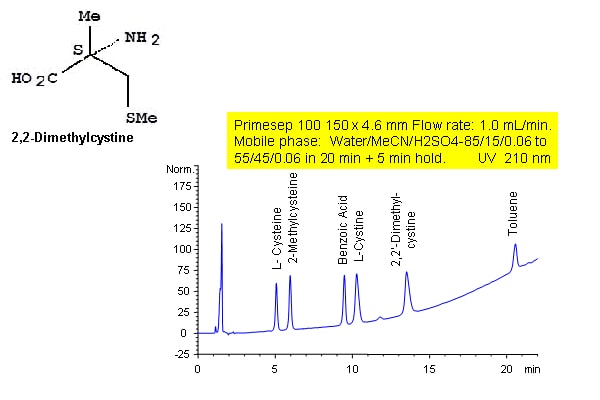
Primesep 100 separates a mixture of polar and nonpolar compounds in one analytical run. The amino acid cysteine; amino acid derivatives L-cystine, 2,2-dimethylcystine, and 2-methylcysteine; the polar acid benzoic acid; and the nonpolar neutral toluene are separated by a gradient using a combination of polar and hydrophobic interactions. The separation method uses a mobile phase mixture of water, acetonitrile (MeCN, ACN) and sulfuric acid (H2SO4) with UV detection at 210 nm.
Application Name : Hydrophobic and Hydrophilic Compound Separation
Column Name : Primesep 100 Columns
Analytes : Toluene, Benzoic acid, Cystine, 2-Methylcysteine, L-Cysteine, 2,2-Dimethylcystine, L-Cystine
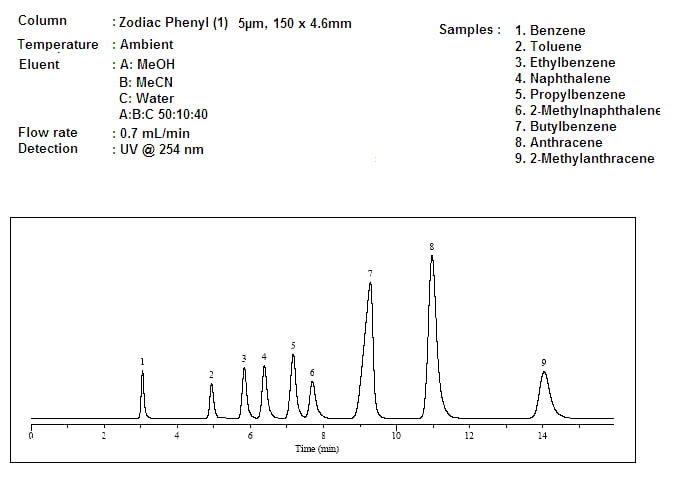
Application Name : Aromatic Hydrocarbons
Column Name : Zodiac Phenyl(1) Column
Analytes :Benzene, Toluene, Naphthalene, Ethylbenzene, Propylbenzene, Butylbenzene, 2-Methylanthracene, Anthracene, 2-methylnaphthalene
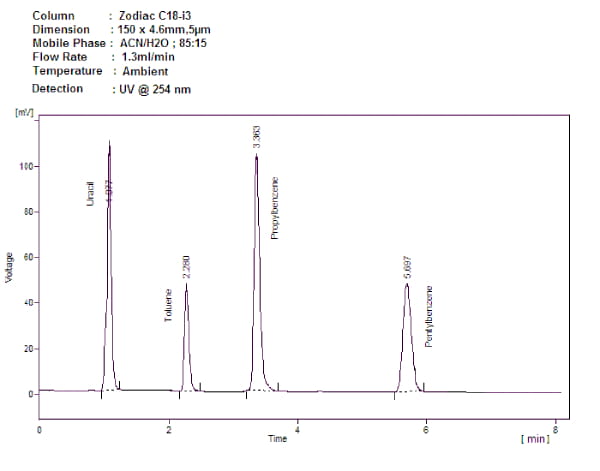
Application Name : Application Of Uracil and Alkylbenzenes
Column Name : Zodiac C18 -i3 Column
Analytes : Uracil, Toluene, Propylbenzene, pentylbenzene
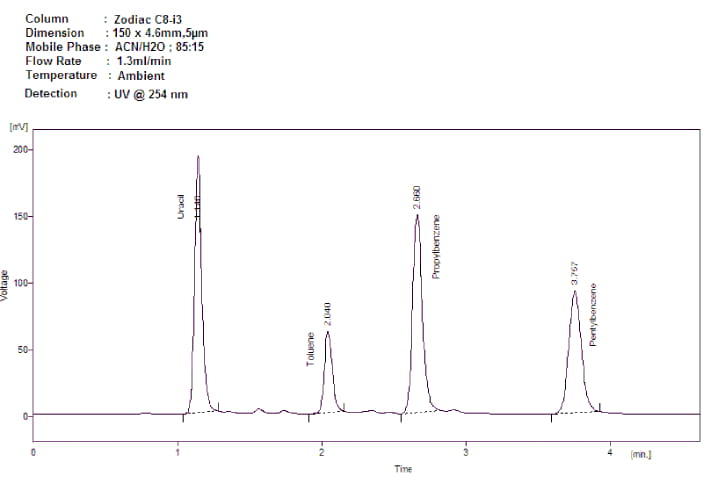
Application Name : Application Of Uracil and Alkylbenzenes
Column Name : Zodiac C8 -i3 Column
Analytes : Uracil, Toluene, Propylbenzene, pentylbenzene
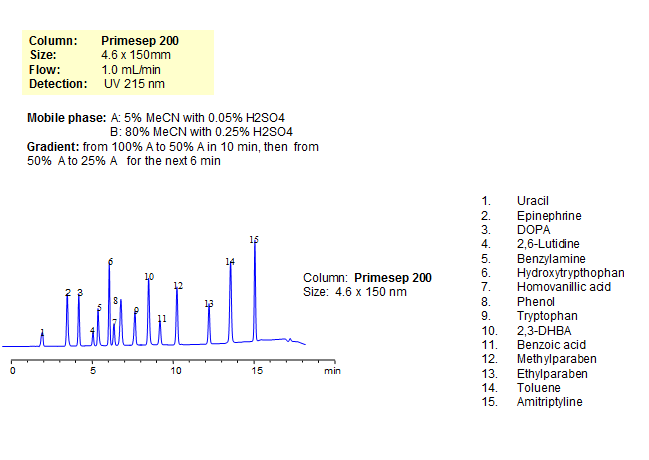
Analytical chemists face multiple complex separations everyday. Very often, complex mixtures containing various compounds need to be analyzed in a single run. Traditional reversed-phase chromatography has challenges for retention of polar-neutral, polar-acidic and polar-basic compounds in mixtures with hydrophobic compounds. We have developed a universal screening method for analysis of complex mixtures containing polar-neutral, polarbasic, polar-acidic, hydrophobic-neutral and hydrophobic-basic compounds. The method employs Primesep 200 mixed-mode reversed-phase cation-exchange column and a simple mobile phase containing ACN/water/sulfuric acid. The low pH of the mobile phase helps suppress ionization of polar-acidic compounds, making them slightly hydrophobic. Hydrophobic and hydrophilic neutral compounds are retained by RP mechanism, while basic hydrophilic and basic hydrophobic compounds are retained by cation-exchange mechanism. Abbreviations: PN-polar neutral, PB-polar basic, PA-polar acidic, HN-hydrophobic neutral, HB-hydrophobic basic
Application Name : Universal HPLC-UV Method for Complex Mixtures
Column Name : Primesep 200 Columns
Analytes : Homovanillic acid, Amitriptyline, Uracil, Toluene, Benzoic acid, Benzylamine, DOPA (3,4-dihydroxy-L-phenylalanine), Phenol, 2,6-Lutidine, Epinephrine Sulfonate, Hydroxytryptophan, Tryptophan, 2,3-DHBA, Methylparaben, Ethylparaben
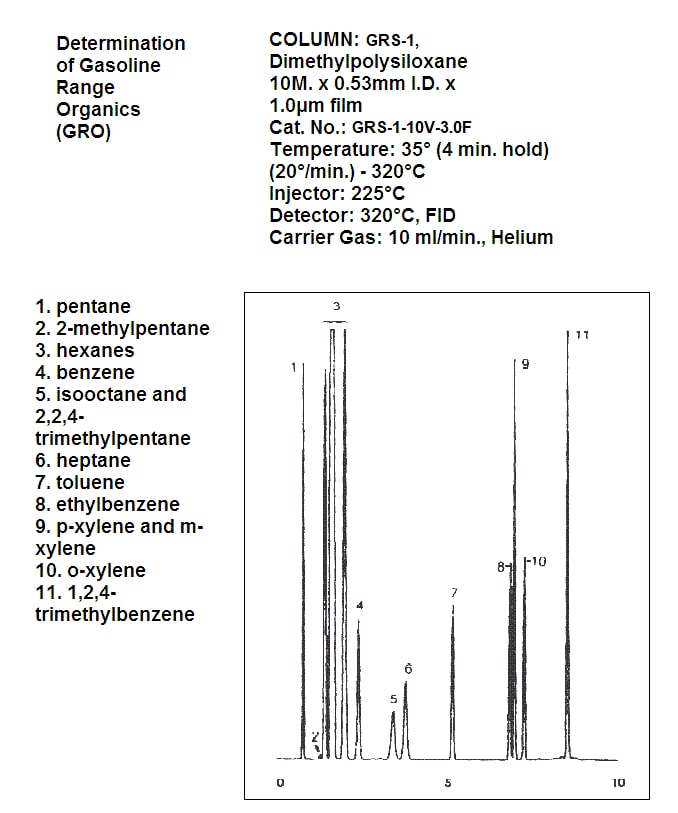
Application Name : Determination of Gasoline Range Organics (GRO)
Column Name : GRS – 1 GC Capillary Column
Analytes : Benzene, Toluene, Ethylbenzene, pentane, 2-methylpentane, Heptane, Hexanes, Isooctane and 2,2,4-trimethylpentane, p-xylene and m-xylene, o-xylene, 1,2,4-trimethylbenzene
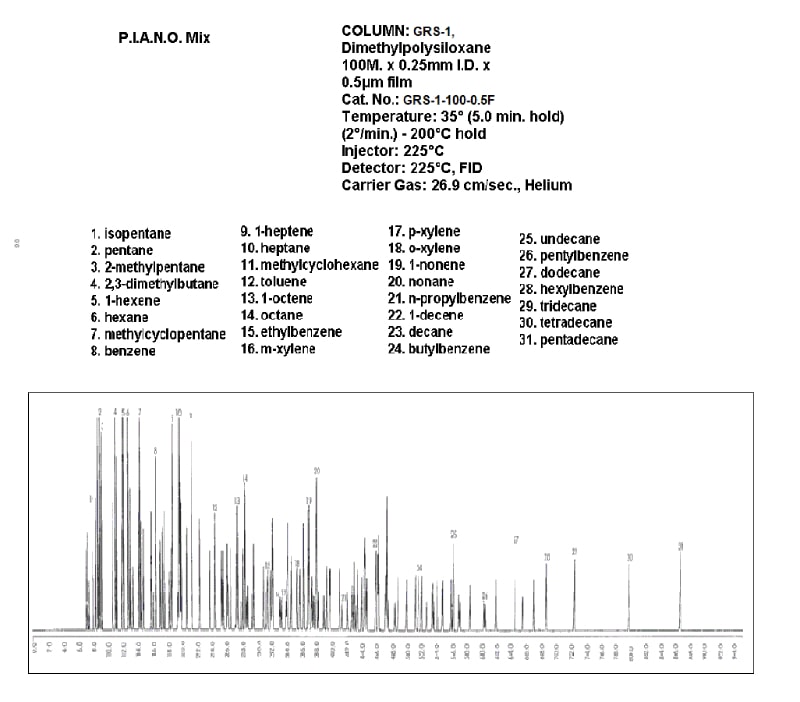
Application Name : P.I.A.N.O. Mix
Column Name : GRS – 1 GC Capillary Column
Analytes : Benzene, Toluene, Ethylbenzene ,Butylbenzene, pentane, 2-methylpentane, Hexane, Heptane, Decane, Dodecane ,Tridecane, Tetradecane, Pentadecane, o-xylene, Isopentane, 2,3-dimethylbutane, 1-hexene, Methylcyclopentane, 1-heptene, Methylcyclohexane, 1-octene, m-xylene, p-xylene, 1-nonene, Nonane, n-propylbenzene, 1-decene, undecane, pentylbenzene, Hexylbenzene
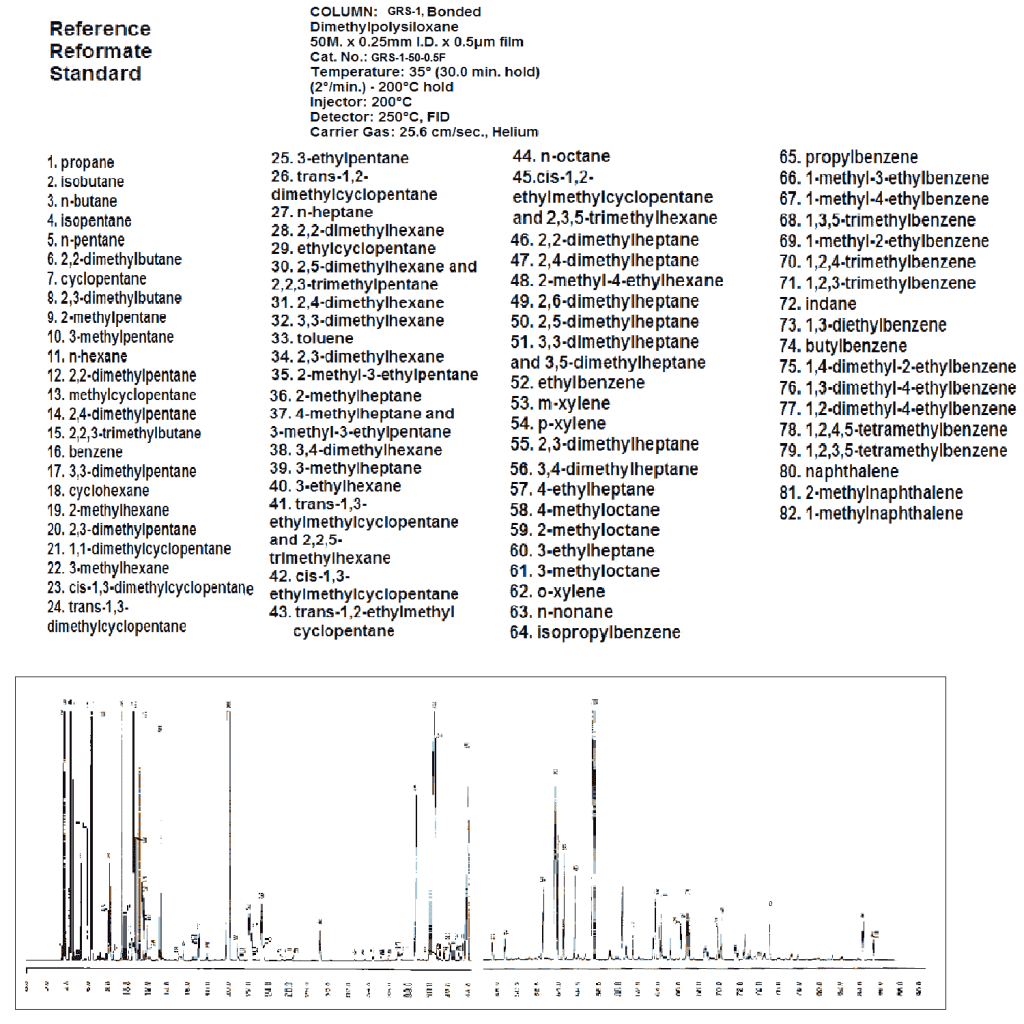
Application Name : Reference Reformate Standard
Column Name : GRS – 1 GC Capillary Column
Analytes : Benzene, Toluene, Naphthalene , Ethylbenzene, Propylbenzene,Butylbenzene, Propane , 2-methylpentane, 2,4-dimethylpentane, o-xylene, Isopentane, 1,2,4-trimethylbenzene, 2,3-dimethylbutane, Methylcyclopentane, m-xylene, p-xylene, isobutane, 2,2-dimethylbutane, 3-methylpentane, 2,2,3-trimethylbutane, Cyclohexane, n-butane, cyclopentane, n-hexane, 2,2-dimethylpentane, 3,3-dimethylpentane, 2-methylhexane, 2,3-dimethylpentane, 1,1-dimethylcyclopentane, 3-methylhexane, cis-1,3-dimethylcyclopentane, trans-1,3-dimethylcyclopentane, 2,5-dimethylhexane and 2,2,3-trimethylpentane, 2,4-dimethylhexane, 2,3-dimethylhexane, 2-methylheptane, 3,4-dimethylhexane, 2,4-dimethylheptane, 2,6-dimethylheptane, 2,5-dimethylheptane, 2,3-dimethylheptane, n-pentane, 3-ethylpentane, trans-1,2-dimethylcyclopentane, n-heptane, Ethylcyclopentane, 3,3-dimethylhexane, 2-methyl-3-ethylpentane, 4-methylheptane and 3-methyl-3-ethylpentane, trans-1,2-ethylmethylcyclopentane, n-octane, cis-1,2-ethylmethylcyclopentane and 2,3,5-trimethylhexane, 2,2-dimethylheptane, 2-methyl-4-ethylhexane, 3,3-dimethylheptane and 3,5-dimethylheptane, 3,4-dimethylheptane, 4-ethylheptane, n-nonane, 2,2-dimethylhexane, trans-1,3-ethylmethylcyclopentane, 2-methyloctane, 3-ethylheptane, 3-methyloctane, isopropylbenzene, 1-methyl-3-ethylbenzene, 1-methyl-4-ethylbenzene, 1,3,5-trimethylbenzene, 1-methyl-2-ethylbenzene, 1,2,3, trimethylbenzene, Indane, 1,3-diethylbenzene, 4-methyloctane, 3-ethylhexane, 1,4-dimethyl-2-ethylbenzene, 1,3-dimethyl-4-ethylbenzene, 1,2-dimethyl-4-ethylbenzene, 1,2,4,5-tetramethylbenzene, 1,2,3,5-tetramethylbenzene, 2-methylnaphthalene, 1-methylnaphthalene
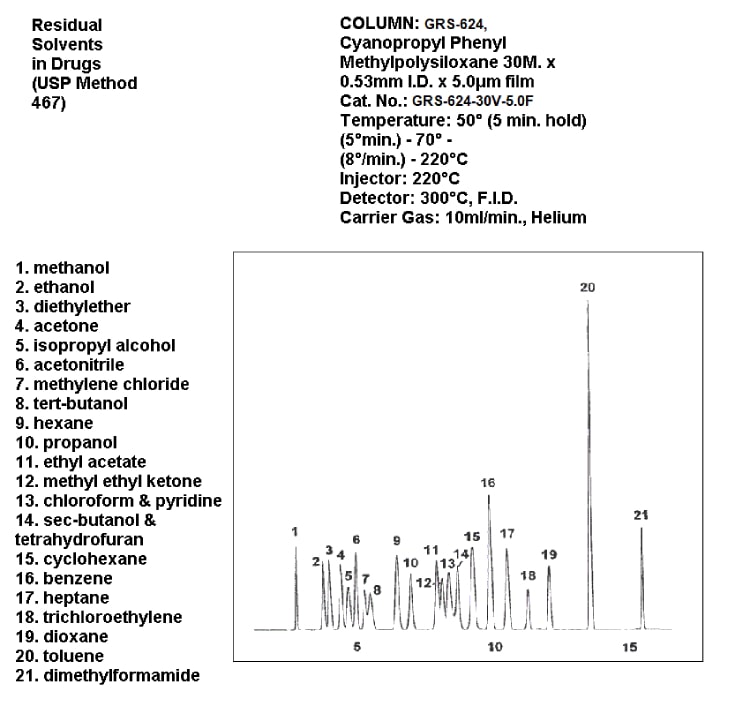
Application Name : Residual Solvents in Drugs (USP Method 467)
Column Name : GRS-1 GC Capillary Column
Analytes : Benzene, Toluene, Ethanol, Methanol, Pyridine, acetone, Heptane, Trichloroethylene, Isopropanol, Methylene chloride, sec-butanol, Acetonitrile, diethylether, tert-butanol, propanol, Methyl ethyl ketone, Ethyl acetate, chloroform & hexane, Tetrahydrofuran, Cyclohexane, 1,4-dioxane, dimethylformamide
Application Name :
HPLC Separation of Amino Acids, Bases, Acids, and Neutrals on Zodiac HST TH
Separation of Generic Compounds by HPLC on Zodiac HST OG
Separation of Acids, Bases, Amino Acids, and Neutral Compounds using Mixed-Mode Chromatography
Get Your Quote or Call: 040-29881474
We focus on supporting laboratory workflows & optimizing lab-wide operations
